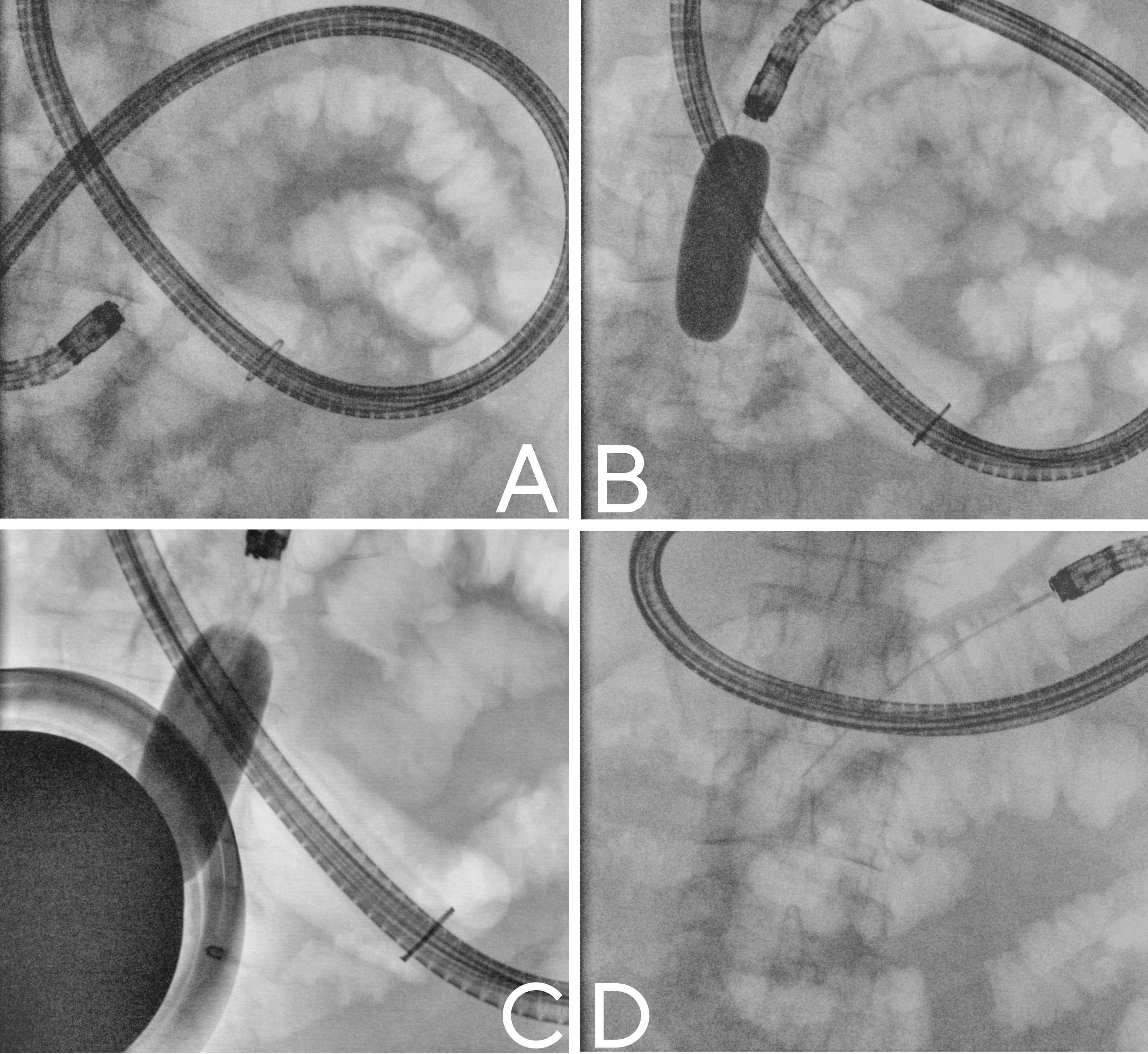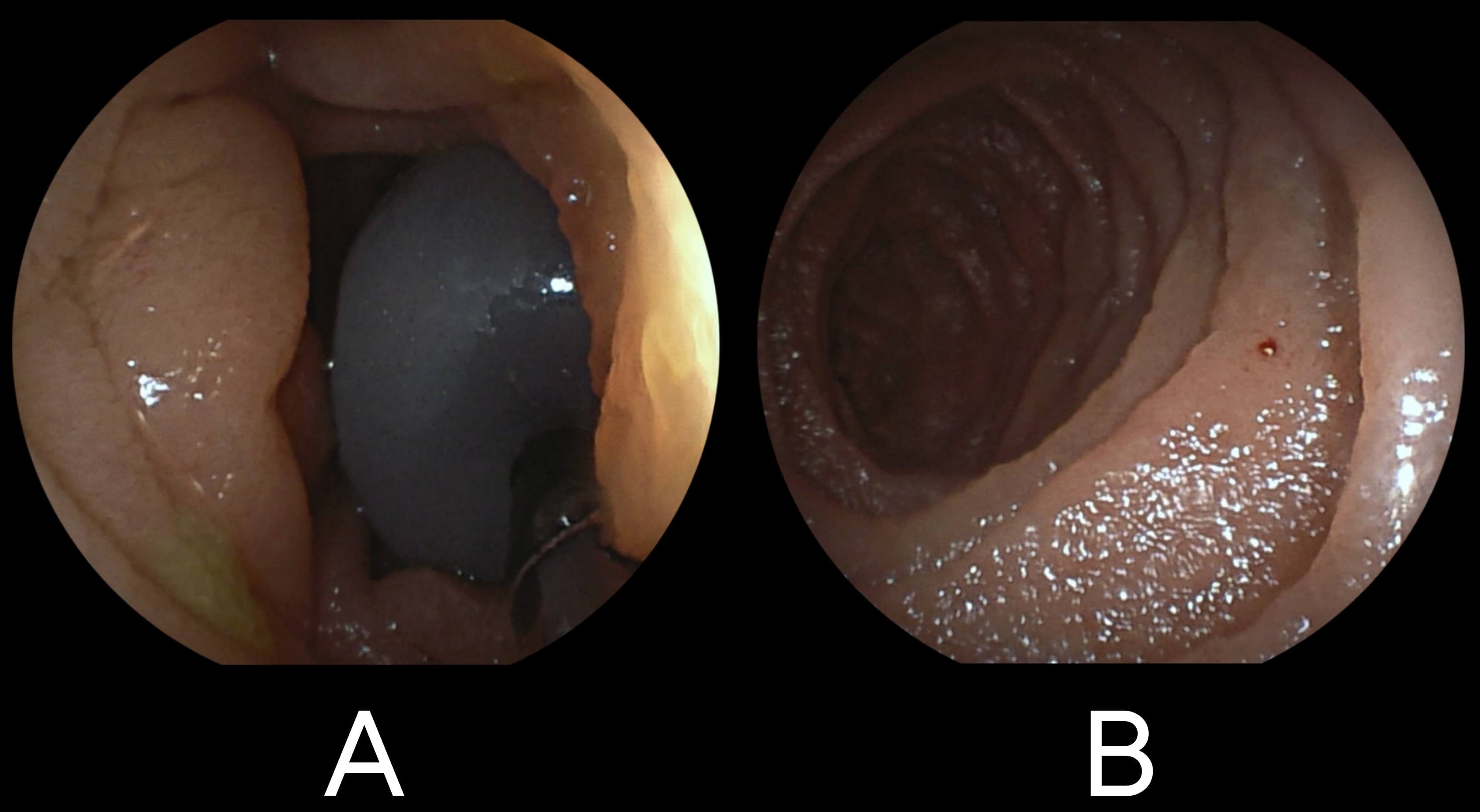Monday Poster Session
Category: Small Intestine
P4105 - Magnetic Balloon-Assisted Double Balloon Enteroscopy for Small Bowel Bleeding: A Case Report
Monday, October 27, 2025
10:30 AM - 4:00 PM PDT
Location: Exhibit Hall

Paolo Minerba, MD (he/him/his)
ASST Pavia
Voghera, Lombardia, Italy
Presenting Author(s)
Award: ACG Presidential Poster Award
Paolo Minerba, MD, Giacomo Rossi, MD, Cesare Rosa, MD, Michela Ilaria Parzanese, MD, Costanza Alvisi, MD
ASST Pavia, Pavia, Lombardia, Italy
Introduction: A 69-year-old woman with a history of chronic anemia requiring multiple transfusions and several episodes of gastrointestinal leading to repeated emergency department visits was evaluated. Capsule endoscopy identified a bleeding lesion in the mid-small bowel. Subsequent device-assisted enteroscopy using a short double-balloon enteroscope (155 cm length, 3.2 mm working channel) failed to reach the lesion despite a 2-hour procedure.
We therefore decided to employ a novel magnetic balloon anchoring system in order to avoid loop formation and facilitate deep insertion. This system includes a through-the-scope balloon catheter filled with ferromagnetic fluid and anchored via an external abdominal magnet. This setup stabilizes the endoscope, allowing effective loop resolution via retraction and straightening, minimizing scope slippage.
Case Description/
Methods: We performed a second enteroscopy using the same scope, assisted by the magnetic balloon anchoring system. The endoscopist advanced the scope using standard double-balloon technique until a loop developed. Under fluoroscopic guidance, the magnetic balloon was inflated and magnetically anchored to the abdominal wall, in conjunction with the overtube and scope balloons. This triple-anchoring approach allowed for effective loop resolution by retracting and straightening the scope. After loop resolution, the magnetic balloon was removed and the scope advanced with standard technique.
This loop correction method was performed seven times, enabling advancement up to 250 cm into the small bowel in just 75 minutes. A 2 mm non-bleeding vascular lesion (Type IIb Yano-Yamamoto Classification) was detected and treated with Argon Plasma Coagulation. At two-week follow-up, hemoglobin was stable at 9 g/dL with no recurrent bleeding.
Discussion: To our knowledge, this is the first reported case of a magnetic balloon-assisted double-balloon enteroscopy enabling deeper and more efficient small bowel exploration. The triple anchorage system allowed rapid and repeated loop resolution, consistently reducing procedure time and improving scope stability, particularly during Argon Plasma Coagulation. Additionally, the short enteroscope improved maneuverability during the intervention.
This case supports the clinical potential of magnetic balloon technology in enteroscopy, particularly in complex or incomplete procedures, enhancing both diagnostic and therapeutic outcomes.

Figure: Straightening and loop resolution under fluoroscopic guidance. A) Loop formation; B) Inflation of the magnetic balloon; C) Magnetic ballon anchored to the abdominal wall via an external abdominal magnet; D) Loop resolution

Figure: A) Endoscopic view, magnetic balloon inflated; B) Endoscopic view, a 2 mm non-bleeding vascular lesion (Type IIb Yano-Yamamoto Classification) was detected
Disclosures:
Paolo Minerba indicated no relevant financial relationships.
Giacomo Rossi indicated no relevant financial relationships.
Cesare Rosa indicated no relevant financial relationships.
Michela Ilaria Parzanese indicated no relevant financial relationships.
Costanza Alvisi indicated no relevant financial relationships.
Paolo Minerba, MD, Giacomo Rossi, MD, Cesare Rosa, MD, Michela Ilaria Parzanese, MD, Costanza Alvisi, MD. P4105 - Magnetic Balloon-Assisted Double Balloon Enteroscopy for Small Bowel Bleeding: A Case Report, ACG 2025 Annual Scientific Meeting Abstracts. Phoenix, AZ: American College of Gastroenterology.
Paolo Minerba, MD, Giacomo Rossi, MD, Cesare Rosa, MD, Michela Ilaria Parzanese, MD, Costanza Alvisi, MD
ASST Pavia, Pavia, Lombardia, Italy
Introduction: A 69-year-old woman with a history of chronic anemia requiring multiple transfusions and several episodes of gastrointestinal leading to repeated emergency department visits was evaluated. Capsule endoscopy identified a bleeding lesion in the mid-small bowel. Subsequent device-assisted enteroscopy using a short double-balloon enteroscope (155 cm length, 3.2 mm working channel) failed to reach the lesion despite a 2-hour procedure.
We therefore decided to employ a novel magnetic balloon anchoring system in order to avoid loop formation and facilitate deep insertion. This system includes a through-the-scope balloon catheter filled with ferromagnetic fluid and anchored via an external abdominal magnet. This setup stabilizes the endoscope, allowing effective loop resolution via retraction and straightening, minimizing scope slippage.
Case Description/
Methods: We performed a second enteroscopy using the same scope, assisted by the magnetic balloon anchoring system. The endoscopist advanced the scope using standard double-balloon technique until a loop developed. Under fluoroscopic guidance, the magnetic balloon was inflated and magnetically anchored to the abdominal wall, in conjunction with the overtube and scope balloons. This triple-anchoring approach allowed for effective loop resolution by retracting and straightening the scope. After loop resolution, the magnetic balloon was removed and the scope advanced with standard technique.
This loop correction method was performed seven times, enabling advancement up to 250 cm into the small bowel in just 75 minutes. A 2 mm non-bleeding vascular lesion (Type IIb Yano-Yamamoto Classification) was detected and treated with Argon Plasma Coagulation. At two-week follow-up, hemoglobin was stable at 9 g/dL with no recurrent bleeding.
Discussion: To our knowledge, this is the first reported case of a magnetic balloon-assisted double-balloon enteroscopy enabling deeper and more efficient small bowel exploration. The triple anchorage system allowed rapid and repeated loop resolution, consistently reducing procedure time and improving scope stability, particularly during Argon Plasma Coagulation. Additionally, the short enteroscope improved maneuverability during the intervention.
This case supports the clinical potential of magnetic balloon technology in enteroscopy, particularly in complex or incomplete procedures, enhancing both diagnostic and therapeutic outcomes.

Figure: Straightening and loop resolution under fluoroscopic guidance. A) Loop formation; B) Inflation of the magnetic balloon; C) Magnetic ballon anchored to the abdominal wall via an external abdominal magnet; D) Loop resolution

Figure: A) Endoscopic view, magnetic balloon inflated; B) Endoscopic view, a 2 mm non-bleeding vascular lesion (Type IIb Yano-Yamamoto Classification) was detected
Disclosures:
Paolo Minerba indicated no relevant financial relationships.
Giacomo Rossi indicated no relevant financial relationships.
Cesare Rosa indicated no relevant financial relationships.
Michela Ilaria Parzanese indicated no relevant financial relationships.
Costanza Alvisi indicated no relevant financial relationships.
Paolo Minerba, MD, Giacomo Rossi, MD, Cesare Rosa, MD, Michela Ilaria Parzanese, MD, Costanza Alvisi, MD. P4105 - Magnetic Balloon-Assisted Double Balloon Enteroscopy for Small Bowel Bleeding: A Case Report, ACG 2025 Annual Scientific Meeting Abstracts. Phoenix, AZ: American College of Gastroenterology.

